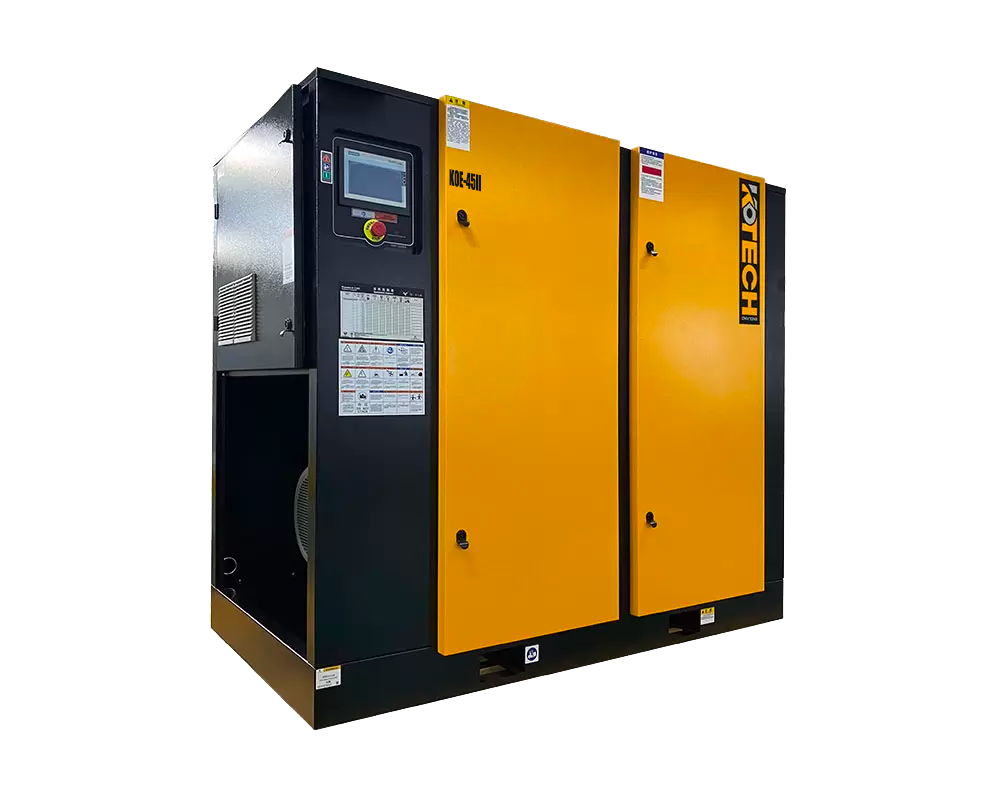What does 2 Stage Air Compressor Mean?
In the recent years, the global energy crisis and the global climate warming have prompted human’s increasing awareness of energy conservation.
Energy conservation and emission reduction have become a common goal in various industries and fields. Permanent magnet integrated screw air compressors have become a mainstream product in the market. Compared with the traditional screw air compressors, under actual operating conditions, permanent magnet screw air compressors can save more than 30% of energy.
For specifications of 55kW and more, the energy consumption of single-stage air compressor on the current market does not meet the first-level energy efficiency index generally.
The two stage air compressor method and intercooling has obvious energy efficiency advantages. Compared with single-stage air compressors, it can effectively reduce the inlet temperature of two-stage air compressor and reduce power consumption; At the same time, it uses the advantages of two-stage air compressors such as low pressure ratio and low discharge temperature to reduce leakage loss, improving volumetric efficiency, and reduce the cost of after-cooler and oil cooling, which help improve system energy efficiency.
Comparison of similar products in the market
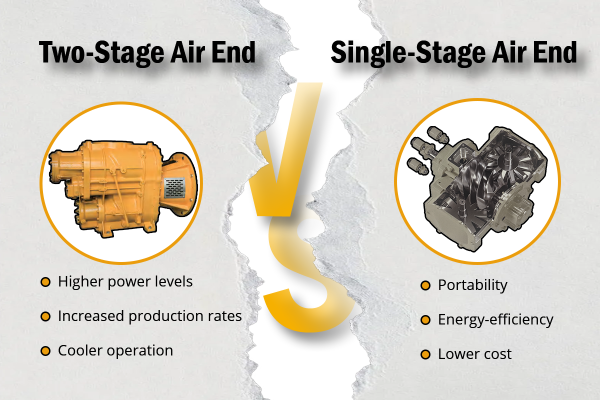
Comparison of similar products in the marketAt present, the market has the following three forms of inverter-driven two-stage compression screw air compressor: asynchronous inverter gear-driven two-stage compression screw air compressor, permanent magnet inverter gear-driven two-stage compression screw air compressor and permanent magnet integrated two-stage compression screw air compressor.
However, as the screw air compressor operates under variable frequency conditions, it will not be able to achieve the optimum pressure in the main engine when it operates at low speeds as the rotational speed decreases.
The gear-driven two-stage compression mainframe will only meet the most suitable results at a specific pressure specific speed.In addition, for host systems with different exhaust pressures, the intermediate pressure is also fixed due to the fixed gear ratio, which also fails to achieve optimal energy efficiency.In summary, the gear-driven two-stage compression mainframe has the best energy efficiency value only at a specific pressure and specific speed.
The working principle of the permanent magnet integrated two-stage compression screw air compressor is as follows:
The permanent magnet integrated two-stage compression screw air compressor breaks the structure of the traditional screw mainframe, which consists of a delivery shaft with two pairs of screw rotors with different diameters, lengths and rotation speeds, and its working principle is similar to that of single-stage compression, which realises the whole process of suction, compression and exhausting of the screw air compressor.
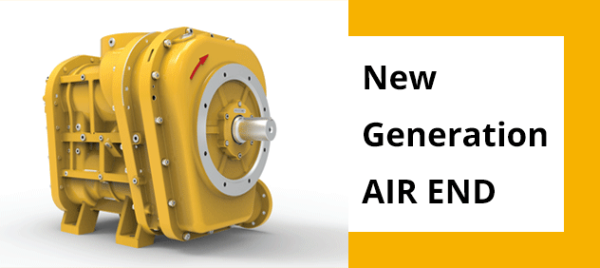
Energy saving principle of permanent magnet synchronous motor
The energy saving of two-stage permanent magnet air compressor is divided into two aspects, the first aspect is the permanent magnet synchronous motor, which has the following outstanding advantages.
1.High Efficiency
Permanent magnet synchronous motor has a wide high efficiency area, especially when running at low speed, it has high efficiency, which is not comparable with Y series asynchronous motor.
Efficiency of permanent magnet synchronous motor and Y series asynchronous motor.
It can be seen that although their maximum efficiency is close, the efficiency of permanent magnet synchronous motor in the range of (30-100)%nN is close to the maximum efficiency, while the high efficiency area of Y series asynchronous motor is close to the rated speed (N).
In actual operation, the air compressor mainly operates in the speed range of (30-100)%nN when the load changes.
At this time, the efficiency of Y series asynchronous motor is only about (50-70)%, so Y series asynchronous motor running speed in 75-100%, the efficiency is better, and the efficiency of 5-100% of permanent magnet synchronous motor is close to the highest efficiency, energy saving effect is very obvious.
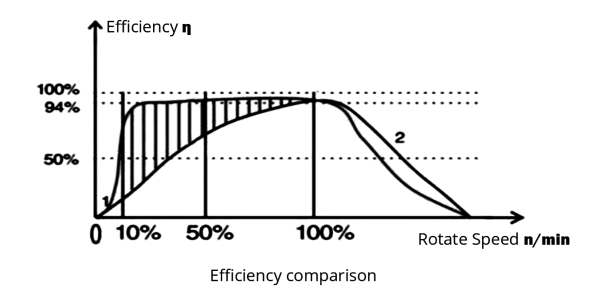
1-Efficiency curve of permanent magnet synchronous motor; 2-Efficiency curve of ordinary three-phase asynchronous motor
(Efficiency – speed curve comparison)
2. Power Change
The power factor does not change with the number of poles, so the power factor is high because the permanent magnet synchronous motor does not need excitation to establish the magnetic field, there is no reactive power loss, so the power factor is very high, the rated power factor can be more than 0.95, and multi-pole, low-speed operation can ensure that the high power factor remains unchanged.
The rated power factor of Y series asynchronous motor is only about 0.9, and its power factor will be reduced with the increase of poles and also with the reduction of operating speed.
This is unfavourable for air compressors running at low speeds.
3. High Starting Torque
The ratio of starting torque to rated torque of permanent magnet synchronous motor can be more than 3 times, while the general Y series asynchronous motor is only 1.6 times.
It is very suitable for loads such as oil pumping machines, air compressors and other loads that require heavy-duty starting.
Two-stage screw air compressor energy-saving principle
The traditional single-stage oil-injected screw compressor as the name suggests is a pair of rotors and two-stage compressor is two pairs of rotors, compared to single-stage compression, two-stage compressor has obvious energy-saving advantages.
1.Two-stage compression reduces the compression ratio of each stage and improves volumetric efficiency
Compared to single-stage compression, two-stage compression reduces the compression ratio of each stage, improves volumetric efficiency, and reduces internal and external leakage in each stage.
For example, single-stage compression screw machine rotor: inlet end pressure of atmospheric pressure of about 1bar, through the rotor compression to the outlet pressure of 8bar, the compression process of the compression ratio of 8/1, that is, single-stage compressor compression ratio of 8.
And two-stage inlet end pressure of about 1bar, through the first rotor compression to the outlet pressure of 3bar or so, and then into the second rotor compression pressure to enhance the pressure to the required 8bar.
The compression ratio of the first low-pressure rotor is about 1 bar.
The compression ratio of the first stage low pressure rotor is about 3, and the compression ratio of the second stage high pressure rotor is 8/3≈2.67, i.e. the compression ratio of the second stage is about 2.67.
The maximum compression ratio of the two-stage compression rotor system is about 3.
2. Isothermal Compression for Improved Compressor Efficiency
Isothermal compression is a mixture of oil and gas in the first exhaust into the second suction before, can be fully mixed, play the role of inter-stage cooling, this more fully mixed oil and gas mixture into the compressor’s second stage for compression, but also to make the second stage of the compression process is more close to the isothermal process, improve the energy efficiency of the compressor.
The combination of the first-stage and second-stage compressor rotors in one housing, and respectively, through the helical gear direct drive, so that each stage rotor can obtain the best linear velocity, the compression of the highest transfer efficiency.
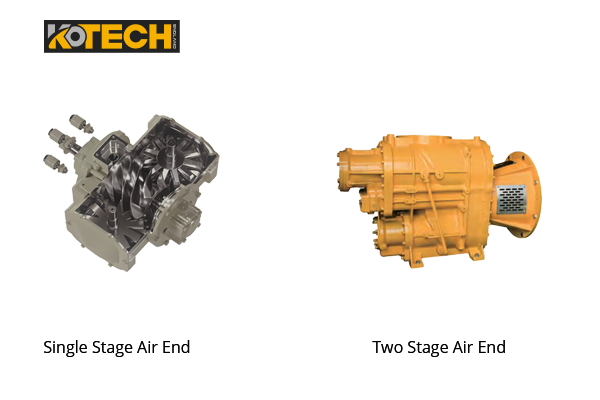
3. Two-stage compression process
Natural air through the air filter into the first stage of compression, in the compression chamber with a small amount of lubricating oil mixing, at the same time will be compressed to the interstage pressure of the gas mixture.
Compressed gas into the cooling channel, and a large number of oil mist contact, thus greatly reducing the temperature.
After cooling, the compressed gas enters the second stage rotor and is compressed to the final discharge pressure.
Finally through the exhaust flange out of the compressor, completing the whole compression process.

(Two-stage compression process)
Therefore, the host of two-stage compression under the same power conditions than the single-stage compression of the oil-injected screw compressor exhaust volume of 10-20% more, it can also be said that under the same conditions of the air volume of two-stage compression of air compressors than single-stage compression of energy-saving air compressor 10-20%.
Double-stage permanent magnet air compressor is energy-saving permanent magnet synchronous motor and energy-saving double-stage compression of the main unit of the combination of energy-saving compressors become another energy-saving products. (View kotech more oil flooded air compressors)
KOE II Series 2-Stage Screw Air Compressor
2-Stage Screw Air Compressor is a type of air compressor that is designed to provide a more consistent and efficient amount of air pressure than a single-stage compressor.
Advantages of two-stage air compressor
1. High-efficiency energy-saving screw host is selected, low noise, low vibration, high efficiency.
2. High-efficiency oil-air separator, service life up to 6000 hours, more energy-saving than traditional filters, large filter area.
3. High-efficiency fin-type large heat exchange area cooler, heat exchange surplus of 30%.
4. Professional new integrated air inlet valve, air inlet adjustment range 0-100%.
5. Intelligent microcomputer control system with remote monitoring function.
6. Two-stage compressor in the same power than a single compressed exhaust volume increased by 15%, can achieve more than 15% of the energy-saving space.
7. The main motor with protection class IP55 energy efficient permanent magnet motor, this optimised coefficient of efficiency compared to other motors about 5% -8% advantage.


